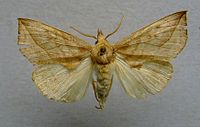
Photo from wikipedia
This study investigates whether female sequential decisions on accepting or rejecting a courting male are based exclusively on the quality of the male present or are affected by the quality… Click to show full abstract
This study investigates whether female sequential decisions on accepting or rejecting a courting male are based exclusively on the quality of the male present or are affected by the quality of potential mates. We used blood-sucking bugs Rhodnius prolixus as experimental subjects as females’ exhibit stereotyped discrimination behavior towards undesirable males, which allows sequential testing of a female’s preference for each male. We expect higher levels of female rejection when the benefit of finding a better quality male overrides the cost of rejecting a mating opportunity. Male quality was manipulated through changes in the feeding regime prior to the experiment because in this species nutritional condition affects males’ reproductive success. Females were simultaneously exposed to both a focal male currently available and a background male potentially available. The quality of each focal and background male could be either low or high and all the possible combinations were tested for each pair (low/high, high/low, high/high, low/low). We found that female rejection behavior depends not only on the quality of the focal male but also on the quality of the background male. This behavioral flexibility may allow females to maximize the benefits of their mating decisions.Significance statementUsing an experimental approach, we study how females of a blood-sucking bug assess male quality and decide whether to accept or reject a mating opportunity in a sequential choice paradigm. Male quality (high/low) and male availability (current/potential) were manipulated. We show that female rejection depends on both the quality of the current and potential mates. Female rejection increases when better quality males are potentially available. This behavioral flexibility may allow females to maximize the benefits of mating decisions.
Journal Title: Behavioral Ecology and Sociobiology
Year Published: 2018
Link to full text (if available)
Share on Social Media: Sign Up to like & get
recommendations!